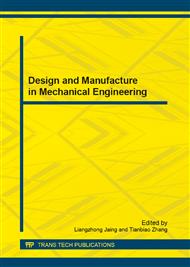[1]
T. Nef, and R. Riener: ARMin – Design of a Novel Arm Rehabilitation Robot, 9th International Conference on Rehabilitation Robotics, ICORR (2005), p.57–60.
DOI: 10.1109/icorr.2005.1501051
Google Scholar
[2]
C. L. Teo, E. Burdet and H. P. Lim: A Robotic Teacher of Chinese Handwriting, In proceedings of 10th Symposium on Haptic Interfaces for Virtual Environment and Teleoperator Systems, HAPTICS (2002), pp.335-341.
DOI: 10.1109/haptic.2002.998977
Google Scholar
[3]
J. J. Abbott, G. D. Hager and A. M. Okamura: Steady-Hand Teleoperation With Virtual Fixtures, In proceedings of 12th IEEE International Workshop on Robot and Human Interactive Communication (2003), pp.145-151.
DOI: 10.1109/roman.2003.1251824
Google Scholar
[4]
T. P. Grantcharov, L. Carstensen and S. Schulze: Objective Assessment of Gastrointestinal Endoscopy Skills Using a Virtual Reality Simulator, Journal of the Society of Laparoendoscopic Surgeon, vol. 9 (2005), pp.130-133.
Google Scholar
[5]
P. A. Kenney, M. F. Wszolek, J. J. Gould, J. A. Libertino, and A. Moinzadeh: Face, Content, And Construct Validity of Dv-Trainer, a Novel Virtual Reality Simulator for Robotic Surgery, Journal of Urology, vol. 73 (2009), pp.1288-1292.
DOI: 10.1016/j.urology.2008.12.044
Google Scholar
[6]
C. A. Avizzano, J. Solis, A. Frisoli and M. Bergamasco: Motor Learning Skill Experiments Using Haptic Interface Capabilities, In proceedings of 11th IEEE International Workshop on Robot and Human Interactive Communication (2002), pp.198-203.
DOI: 10.1109/roman.2002.1045622
Google Scholar
[7]
J. Rodríguez, T. Gutiérrez, S. Casado, and E. J. Sánchez: Training Strategies for Learning a 3D Trajectory With Accuracy, IEEE International Symposium on Haptic Audio-Visual Environments and Games (2010), pp.1-6.
DOI: 10.1109/have.2010.5623979
Google Scholar
[8]
G. Srimathveeravalli and K. Thenkurussi: Motor Skill Training Assistance Using Haptic Attributes, Proceedings of the First Joint Eurohaptics Conference and Symposium on Haptic Interfaces for Virtual Environment and Teleoperator Systems (2005).
DOI: 10.1109/whc.2005.96
Google Scholar
[9]
D. Feygin, M. Keehner, and R. Tendick: Haptic guidance: Experimental Evaluation of a Haptic Training Method for a Perceptual Motor Skill, In proceedings of 10th Symposium on Haptic Interfaces for Virtual Environment and Teleoperator Systems, HAPTICS (2002).
DOI: 10.1109/haptic.2002.998939
Google Scholar
[10]
Y. Yokokohjit, R. L. Hollistt, and T. Kanadett: Toward Machine Mediated Training of Motor Skills -Skill Transfer From Human To Human Via Virtual Environment, In proceedings of 5th IEEE International Workshop on Robot and Communication (1996).
DOI: 10.1109/roman.1996.568646
Google Scholar
[11]
B. Bayart, A. Pocheville, and A. Kheddar: An Adaptive Haptic Guidance Software Module For I-TOUCH: Example Through A Handwriting Teaching Simulation And A 3D Maze, IEEE International Workshop on Haptic Audio Visual Environments and their Applications (2005).
DOI: 10.1109/have.2005.1545651
Google Scholar
[12]
J. Liu, S. C. Cramer, and D. J. Reinkensmeyer: Learning To Perform a New Movement With Robotic Assistance: Comparison of Haptic Guidance and Visual Demonstration, Journal of Neuroengineering and Rehabilitation, vol. 3 (2006).
DOI: 10.1186/1743-0003-3-20
Google Scholar
[13]
E.L.M. Su, G. Ganesh, C. F. Yeong, and E. Burdet: Accurate Micromanipulation Induced by Performing in Unstable Dynamics, 19th IEEE International Symposium on Robot and Human Interactive Communication (2010), pp.762-766.
DOI: 10.1109/roman.2010.5598674
Google Scholar
[14]
E.L.M. Su, G. Ganesh, C. F. Yeong, C. L. Teo, W. T. Ang, and E. Burdet: Effect of Grip Force and Training in Unstable Dynamics on Micromanipulation Accuracy, IEEE Transaction on Haptics: Special Issue on Haptics in Medicine and Clinical Skill Acquisition, vol. 4 (2011).
DOI: 10.1109/toh.2011.33
Google Scholar


